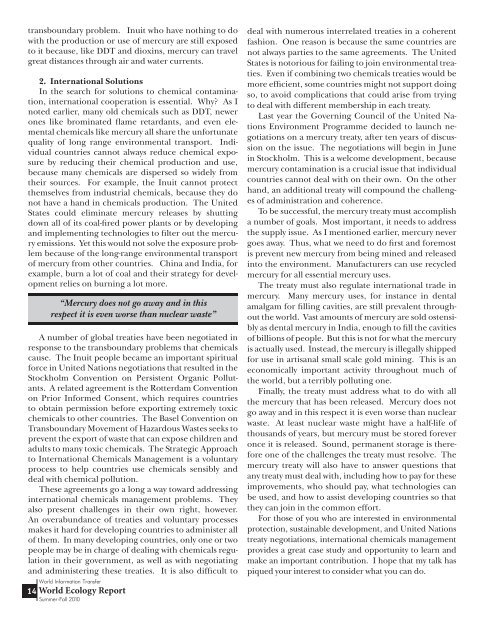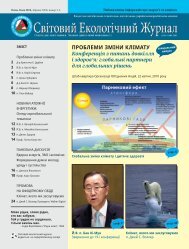V. XXII No 2, 3 - World Information Transfer
V. XXII No 2, 3 - World Information Transfer
V. XXII No 2, 3 - World Information Transfer
Create successful ePaper yourself
Turn your PDF publications into a flip-book with our unique Google optimized e-Paper software.
transboundary problem. Inuit who have nothing to dowith the production or use of mercury are still exposedto it because, like DDT and dioxins, mercury can travelgreat distances through air and water currents.2. International SolutionsIn the search for solutions to chemical contamination,international cooperation is essential. Why? As Inoted earlier, many old chemicals such as DDT, newerones like brominated flame retardants, and even elementalchemicals like mercury all share the unfortunatequality of long range environmental transport. Individualcountries cannot always reduce chemical exposureby reducing their chemical production and use,because many chemicals are dispersed so widely fromtheir sources. For example, the Inuit cannot protectthemselves from industrial chemicals, because they donot have a hand in chemicals production. The UnitedStates could eliminate mercury releases by shuttingdown all of its coal-fired power plants or by developingand implementing technologies to filter out the mercuryemissions. Yet this would not solve the exposure problembecause of the long-range environmental transportof mercury from other countries. China and India, forexample, burn a lot of coal and their strategy for developmentrelies on burning a lot more.“Mercury does not go away and in thisrespect it is even worse than nuclear waste”A number of global treaties have been negotiated inresponse to the transboundary problems that chemicalscause. The Inuit people became an important spiritualforce in United Nations negotiations that resulted in theStockholm Convention on Persistent Organic Pollutants.A related agreement is the Rotterdam Conventionon Prior Informed Consent, which requires countriesto obtain permission before exporting extremely toxicchemicals to other countries. The Basel Convention onTransboundary Movement of Hazardous Wastes seeks toprevent the export of waste that can expose children andadults to many toxic chemicals. The Strategic Approachto International Chemicals Management is a voluntaryprocess to help countries use chemicals sensibly anddeal with chemical pollution.These agreements go a long a way toward addressinginternational chemicals management problems. Theyalso present challenges in their own right, however.An overabundance of treaties and voluntary processesmakes it hard for developing countries to administer allof them. In many developing countries, only one or twopeople may be in charge of dealing with chemicals regulationin their government, as well as with negotiatingand administering these treaties. It is also difficult to<strong>World</strong> <strong>Information</strong> <strong>Transfer</strong>14 <strong>World</strong> Ecology ReportSummer-Fall 2010deal with numerous interrelated treaties in a coherentfashion. One reason is because the same countries arenot always parties to the same agreements. The UnitedStates is notorious for failing to join environmental treaties.Even if combining two chemicals treaties would bemore efficient, some countries might not support doingso, to avoid complications that could arise from tryingto deal with different membership in each treaty.Last year the Governing Council of the United NationsEnvironment Programme decided to launch negotiationson a mercury treaty, after ten years of discussionon the issue. The negotiations will begin in Junein Stockholm. This is a welcome development, becausemercury contamination is a crucial issue that individualcountries cannot deal with on their own. On the otherhand, an additional treaty will compound the challengesof administration and coherence.To be successful, the mercury treaty must accomplisha number of goals. Most important, it needs to addressthe supply issue. As I mentioned earlier, mercury nevergoes away. Thus, what we need to do first and foremostis prevent new mercury from being mined and releasedinto the environment. Manufacturers can use recycledmercury for all essential mercury uses.The treaty must also regulate international trade inmercury. Many mercury uses, for instance in dentalamalgam for filling cavities, are still prevalent throughoutthe world. Vast amounts of mercury are sold ostensiblyas dental mercury in India, enough to fill the cavitiesof billions of people. But this is not for what the mercuryis actually used. Instead, the mercury is illegally shippedfor use in artisanal small scale gold mining. This is aneconomically important activity throughout much ofthe world, but a terribly polluting one.Finally, the treaty must address what to do with allthe mercury that has been released. Mercury does notgo away and in this respect it is even worse than nuclearwaste. At least nuclear waste might have a half-life ofthousands of years, but mercury must be stored foreveronce it is released. Sound, permanent storage is thereforeone of the challenges the treaty must resolve. Themercury treaty will also have to answer questions thatany treaty must deal with, including how to pay for theseimprovements, who should pay, what technologies canbe used, and how to assist developing countries so thatthey can join in the common effort.For those of you who are interested in environmentalprotection, sustainable development, and United Nationstreaty negotiations, international chemicals managementprovides a great case study and opportunity to learn andmake an important contribution. I hope that my talk haspiqued your interest to consider what you can do.




